If you’ve witnessed professional gamers or streamers at work, you may have marveled at the way they pull off a lightning fast sequence of actions with an inhuman level of precision. The secret? Many of them use macros. For someone new to the world of gaming peripherals and optimization, macros can seem like complex programming or even cheating. The truth is that they are powerful tools to improve your game playing experience when used well. This macro guide will guide you through the whole topic from the start.
What is macro? Basically, a macro is a programming command that allows a user to perform multiple actions with a single press of a button. You can think of it as automating repetitive tasks or difficult combinations that would normally need careful timing and several keystrokes. For instance, in a MMORPG, rather than pounding five keys one at a time to spell rotation cast, a macro could press all of these keys for an end-user with a single keystroke. In shooters, that macro could handle recoil or complex movement tricks. Real-world gaming examples include:
MMORPGs (World of Warcraft, Final Fantasy XIV):
- Crafting macros that automate the creation of items with optimal quality
- Rotation macros that execute perfect DPS sequences
- Communication macros for raid callouts
- Targeting macros that prioritize specific enemy types or allies
MOBAs (League of Legends, Dota 2):
- Ward-jump combos executed with frame-perfect timing
- Item activation sequences during teamfights
- Quick-cast combinations for skill shots
- Chat macros for timing objectives
FPS Games (CS:GO, Valorant):
- Bhop (bunny hop) macros for movement optimization
- Weapon switch combos
- Grenade lineup assistants
- Quick-buy sequences for economy rounds
Fighting Games (Street Fighter, Tekken):
- Complex combo inputs requiring precise timing
- Option select macros for defensive plays
- Movement tech like wave dashing
- Character-specific techniques
Understanding what macros actually do, and how they do it, can help you make better ones. At the most basic level, macros essentially work by emulating keyboard and mouse actions at the system level. Essentially, they’re communicating the same signals to your computer as your physical key presses would. This kind of low-level interaction is what makes them so powerful and sometimes hard to distinguish from human input.
Timing is everything with macros. We’re talking millisecond precision here. Most macro software can set intervals in milliseconds, so this gives you insane control over action sequences that would be impossible to pull off in a consistent manner so often by hand. Half a tenth of a second may be the difference between a combo landed and a combo dropped in a fighting game, or between controlling recoil tightly and shooting everywhere in a shooter.
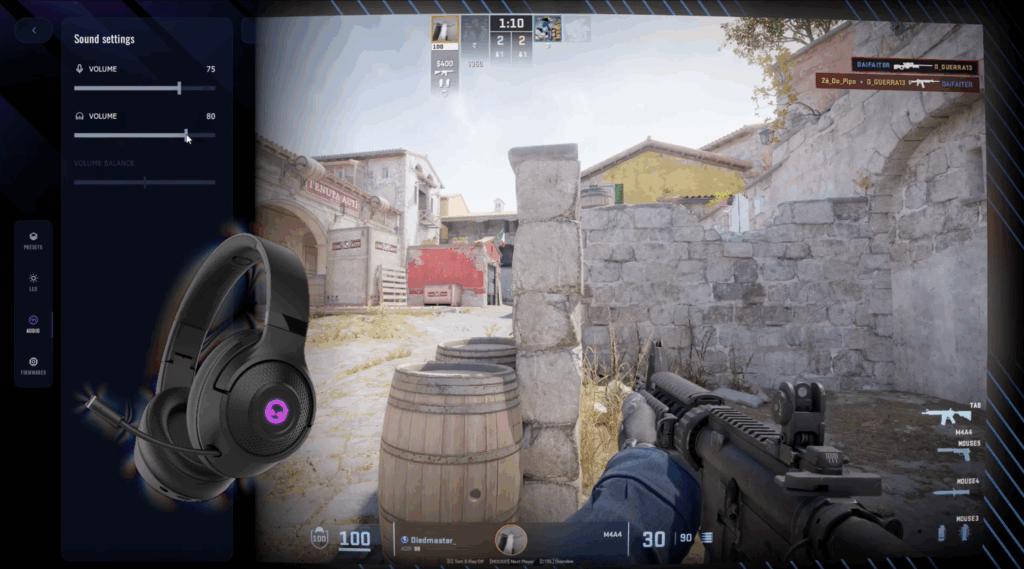
Why Players Use Macros
There are a few great reasons why we need macros.
Firstly, macros will save you from doing the same tasks over and over. Whether you’re gathering resources in an RPG, producing craftables in the hundreds, or spamming your rotation, macros help save you precious time and spare your fingers some pain.
Macros also level the playing field for older players or players who don’t have a lot of disposable income. Now, let’s be real, not everyone has the finger control of a pro esports gamer, or the budget to splurge on premium gaming peripherals. Macros work to close the gap, translating intricate game mechanics into accessible game play.
Many, many players love the challenge of scripting the optimal macro, tuning timers just right, and finding new investments of automation. It turns into a game of game inside game. Some people spend as much time min/maxing their macros as they do playing the game!
Benefits of Using Macros
Macros in gaming have obvious advantages which go beyond convenience. One of the biggest advantages is the fact that repetition will make the complex sequence perform in a reliable way. In timing-heavy games such as fightings or MOBAs, macros can make this frame-perfect input reliable in combat that would otherwise be difficult to maintain for a human. This consistently changes one-off lucky execution of hard techniques into reliable tools at your disposal.
Humans make mistakes through pressure, but macros prevent missing an input, pressing the wrong key, or timing it too quick or too slow, something that can lose precious milliseconds in competitive play. When winning is just a matter of pulling off some critical combo or using abilities in an order, where you can’t mess up by making the wrong click in a finger-breaking sequence, you just took out mechanical skill and made the task a whole lot easier.
With modern macro software, there is a huge amount of customization possible that isn’t just limited to button remapping. Players can customize macros to fit their skills, character builds, or strategies of choice. And we mean truly advanced possibilities: the timing can be adjusted to eliminate lag, if necessary; macros can be temporarily disabled under certain conditions; you can even have a macro’s activation be context-sensitive, adjusting its behavior based on which game mode or character you’re using. Being able to tweak every aspect, macros can keep pace with increasing ability rather than becoming confining crutches.
Speaking of health for a moment, those macros offer some sweet physical perks in the form of decreasing repetitive motions. Types of gaming injuries, such as carpal tunnel syndrome or tendonitis, are frequently the result of the repetition of the same action over and over again. The use of macros can be a means of avoiding these injuries by reducing overuse of a users’ fingers by assigning functions to buttons. This is huge for players who can grind for hours daily and those who already feel the burnout from long play sessions.
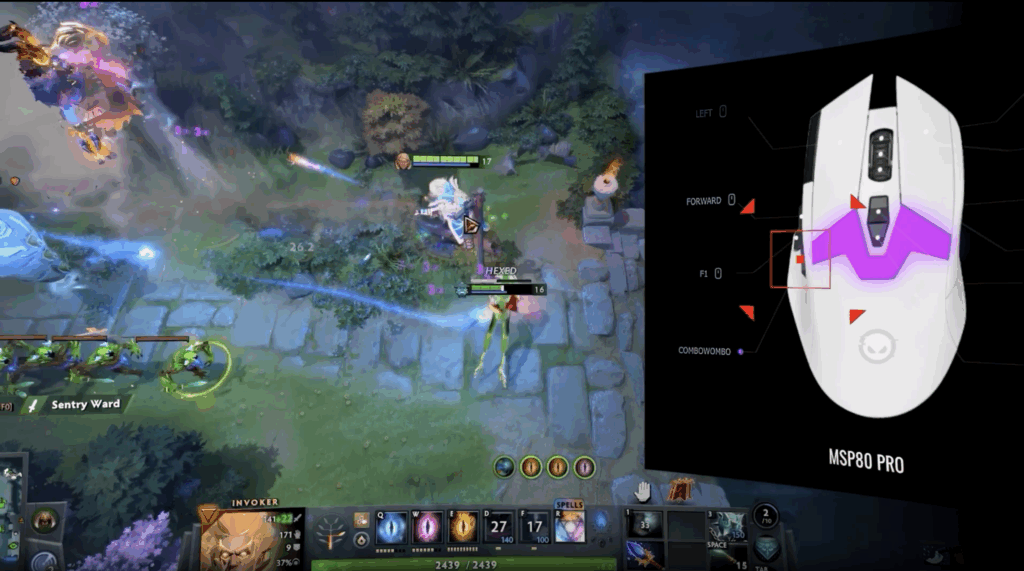
Risks & Why Macros Are Often Banned
As helpful as macros can be in gaming, they occupy an uneasy position on the fence between you and your opponent, so it’s important to familiarize yourself with the risks before you start to learn how to create a macro.
Here’s why that’s a problem – competitive fairness. In PvP scenarios, macros can become a thing that was never meant by the developers. Now imagine a shooter where a player is using recoil control macros and, well, they’re essentially nullifying a fundamental game mechanic meant to counteract the strength of a weapon. Not cool, right?
Anti-cheat tools are becoming increasingly clever. These advanced programs sniff all kinds of macro usage patterns. They’re checking for non-human input patterns (always perfectly timed, every time), 3rd-party software injecting into the game, a suspicious degree of consistency of action, and inhuman-like automated patterns to certain actions that match known macro signatures. Getting caught isn’t a joke and may end with a ban.
Significant competitive games don’t fiddle around with macros. Fortnite, Valorant and ranked World of Warcraft outright ban the majority of bots in their Terms of Service. I’m talking like week to week suspensions or the dreaded year-long ban and you stand to lose years of progress and much hard-earned/purchased content. It is important for gamers to consider the worst-case scenario: is using illegal macros worth a chance of losing an account they’ve been building since day one?
And then there’s the community perception side of it. Even if it’s technically allowed, playing with macros can tank your reputation with other players, who might consider it an unfair advantage, or “soft cheating.” No one wants to be that guy whose macros get called out in chat.
What Is Allowed and What Isn’t
The distinction between what kind of macro would be considered acceptable or prohibited is something that any gamer contemplating automation needs to learn.
So what’s generally cool? Simple 1 to 1 macros that bind one button to one action are generally okay. And quality of life improvements that don’t tinker with the competitive balance get a pass as well. Accessibility macros for handicapped players? Totally legit. Chat macros or emote shortcuts aren’t punishable, either. And if a game has its own macro system, you’re golden using those features.
Now for the no-go zone. Recoil control macros that remove weapon spread? That’s a ban! Auto-clickers and rapid-fire macros greater than human are going to get you the flag fast, too. Motion macros making perfect bunny hops or similar exploits are asking for trouble. Any sort of farming bot or unattended macroing is way out of the ballpark. Same with any macros that read/write game memory or provide you with information you wouldn’t normally be able to access.
Note that the biggest question “Can Steam ban for macro?” doesn’t have a simple answer. Steam itself generally doesn’t ban for macros, but individual games on the platform certainly can and do. Each game is running their own anti-cheat with their own policy. VAC (Valve Anti-Cheat) primarily targets cheats that turn out to be memory-based, but game-specific systems such as EasyAntiCheat or BattlEye actively look for macro users. Bottom line? Get to know the rules of each specific game you’re playing and don’t expect them to be universal.
How to Create a Macro
For anyone who’s thinking of scripting their way into some relatively innocent cheatery in single-player games (or ones that otherwise allow it), here’s how.
Using Gaming Peripheral Software
LORGAR gaming keyboards and mice come with macro creation tool inside LORGAR PLATFORM software that makes it easy for anyone.
Step-by-Step Process:
-
- Install the Software: Get the LORGAR Platform
- Access Macro Section: Open your keyboard or mouse settings and locate the macros section menu
- Create New Macro: Click “Create” button
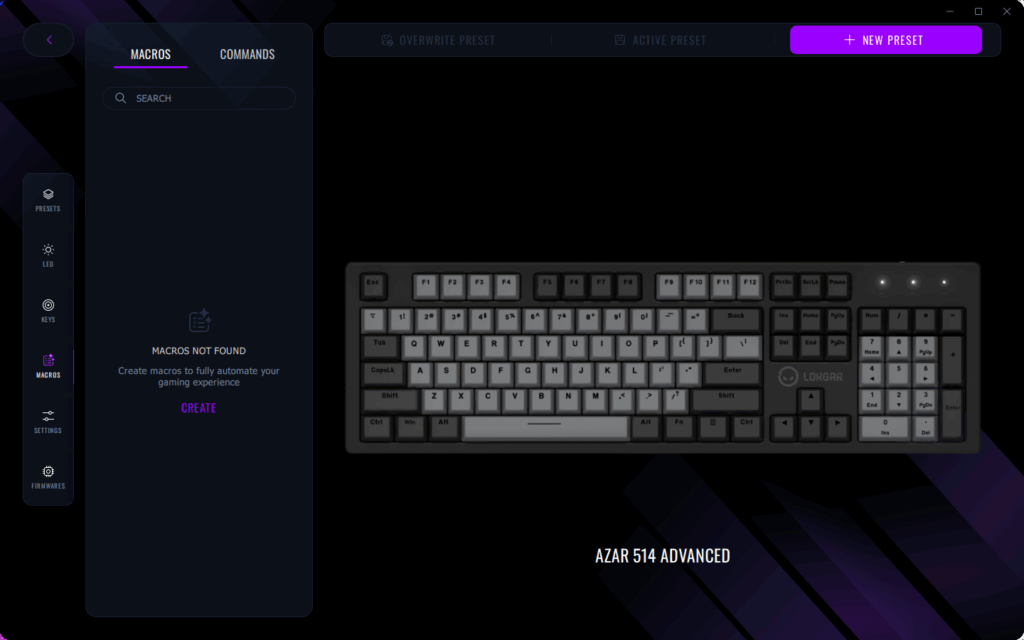
- Recording Methods:
- Recording live: Click “Start Recording” and do what you want in the sequence
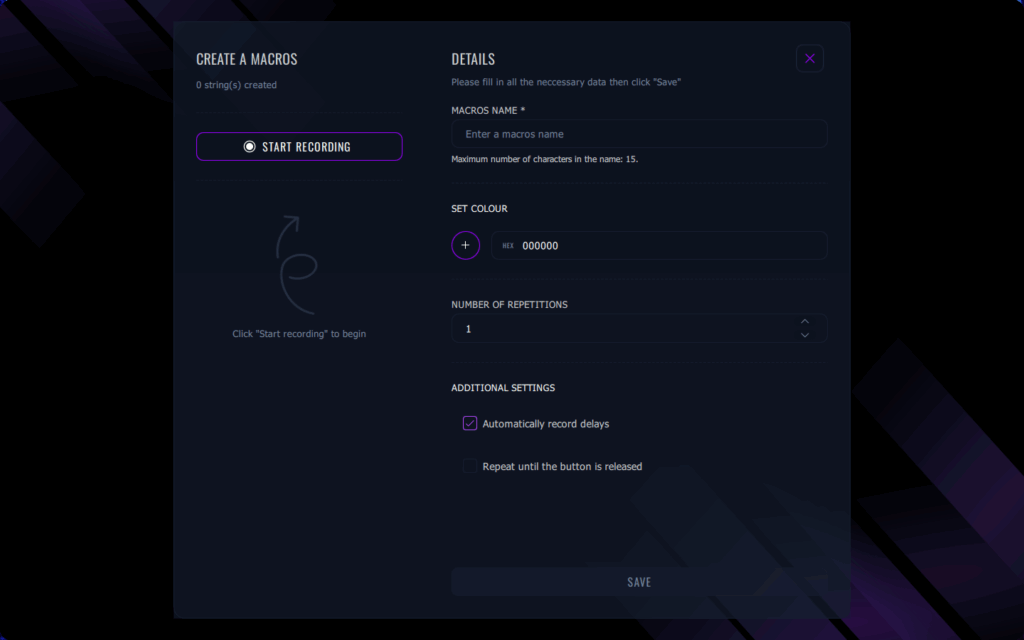
- Manual input: edit each character separately with intentional wait times. You can add or delete each character.
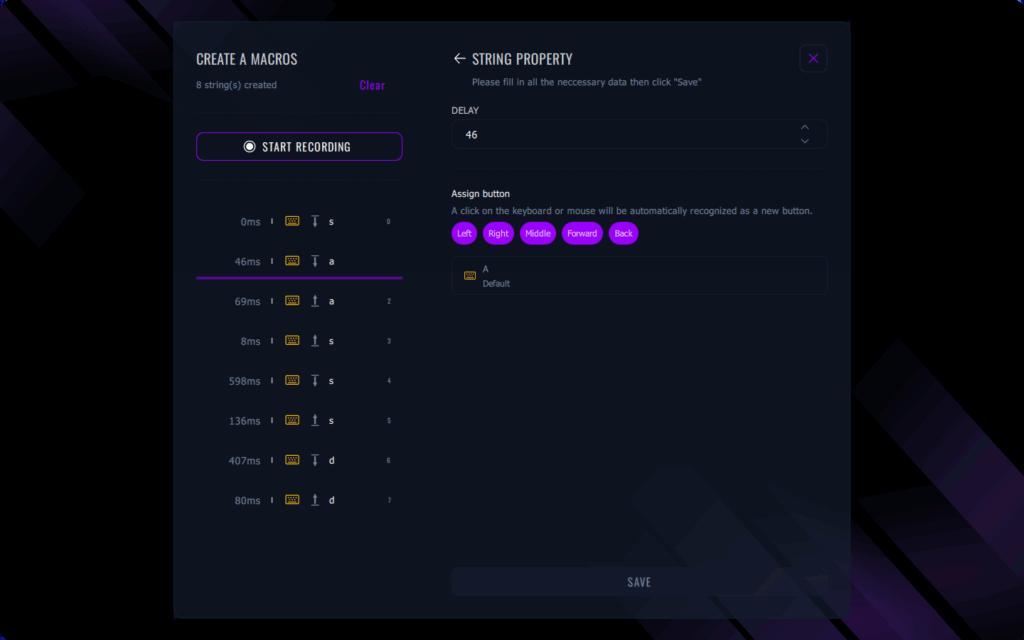
- Recording live: Click “Start Recording” and do what you want in the sequence
- Fine-tune Timing: Set up time lapses between actions for the best performance. By default, “Automatically record delays” checkbox is selected which will capture all delays in milliseconds. Unchecking it makes all actions saved as 0 ms for immediate action or to be used for easier manual adjustment.
- Administrative Actions: assign a name and set colour (in HEX #) for macro to become more identifiable
- Define number of repetitions: “1” by default means that macro will apply the sequence once for each time the assigned button is pressed. Selecting “Repeat until the button is released” checkbox activates infinite mode.
- Assign to Button: Return to the list of available macros and decide which key or button will activate your macro on your device
- Save and Test: Be sure to test on a safe area before use
- Copy and Edit: to create multiple instances of similar macros, instead of recording it from scratch each time, you can copy the existing macro and then edit only the specific details, as desired.
Third-Party Software Solutions
While riskier in multiplayer environments, third-party macro software opens up a whole new world of advanced capabilities that regular peripheral software like LORGAR Platform can’t always match. AutoHotkey on Windows remains the king of macro creation with its powerful scripting language that allows you build seriously complex conditional macros. You’ll need some basic programming knowledge to really tap into its potential, but it’s free and open-source, so you can’t beat the price.
If coding isn’t your thing, there are plenty of gaming-specific tools that offer more user-friendly approaches. X-Mouse Button Control specializes in, well, mouse button customization with macro support. AutoIt provides another scripting option that’s a bit more accessible than AutoHotkey. For those who want something dead simple, Macro Recorder and JitBit Macro Recorder offer straightforward record-and-playback functionality without the steep learning curve. Each tool has its strengths and weaknesses, so picking the right one depends on your technical comfort level and what exactly you’re trying to accomplish.
Advanced Macro Techniques
Once you’ve got that all under your belt, macro making can get pretty advanced. Check out these advanced tricks that’ll raise the bar of possibilities.
The first thing is conditional macros. These intelligent macros will only execute when certain events occur. Perhaps when an ability’s cooldown ends, when you lose 30% of health, or when an enemy of the kind that annoys you arrives. Now instead of just spamming buttons madly, you’re writing smart automation that reads the game state and responds accordingly. It’s as if you’ve got a little assistant covering your back.
Toggle macros make the world of difference to your fingers! What’s the point of holding a key down for an auto-run if you can just toggle it? These are wonderful for MMOs for anything that requires you to channel an ability, or for shooters for sustained fire. Just don’t forget: with great power comes great responsibility. You do still need to be the one to stay in charge of your character.
Want to get really fancy? Multi-level macros combine several simple macros into adaptive sequences. A combat macro that shifts its rotation based upon you fighting a boss or trash mobs, or one that changes based upon their distance to the mob. These scripts can be complex enough to even simulate expert decision-making by a player, but let’s be real that making such a thing is no small-time commitment, nor does it come without game knowledge.
Here’s a pro tip, which might save your account: Add randomization to your macros. By incorporating random delays or very slight execution differences, you’re not setting off anti-cheat LEDs by having so robotic and precise “MACRO USER” patterns. These are milliseconds we’re dealing with – enough to have a human-like feel to them but not enough to hose your combos. Just be aware that, as fancy as your random macros are, they might still be breaking the rules in some games, so be mindful of where you’re using them.
Best Practices for Macro Creation
✔️ Take it slow: You don’t have to be a coding wizard to create some cool macros, but simple ones work best when you’re still learning the ins and outs of using them. Master the fundamentals before advancing.
✔️ Record Everything: Maintain a spreadsheet or document which includes:
- Macro name and purpose
- Key bindings
- Games where it’s used
- Date created and last modified
- Any special conditions or requirements
✔️ Version Control: Store versions of your most crucial macros. And if an update screws everything up you can always roll back.
✔️ Routine Testing: Macros will not always work with game updates. Check your macros after upgrading.
✔️ Back your Profiles up: Export your profiles all the time. Your configurations can be lost due to hardware failure or software upgrade.
✔️ Community Resources: Plenty of games have communities which distribute working macros. These could be resources to learn from, or for inspiration to build your own.
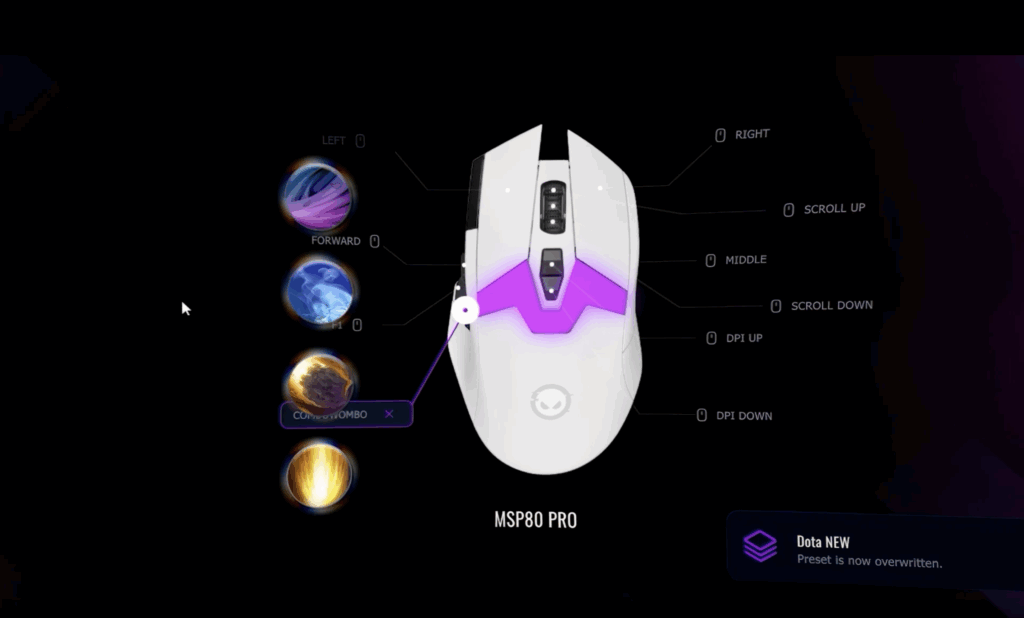
Conclusion
Knowing what are macros in games can open up new avenues of fun for you while playing. Although they provide undeniable advantages in performance, availability, and flexibility, using them has to be done responsibly and under the guidelines set by game makers.
Here’s the thing: macros that improve single-player experiences or function as accessibility features are good additions to gaming. But to leverage these into unfair advantages in competitive multiplayer? That’s when you get into sketchy territory and put your account in danger.
Gaming technology is constantly changing, but the conversation around the legality of macros in games isn’t going anywhere. Some newly released games are baking macro-like actions directly into the game; others are doubling down on policing the practice. The smart move? Keep up to date on the individual guidelines of your games, and when in doubt, don’t take the chances. After all, games are made to be enjoyed, not broken.

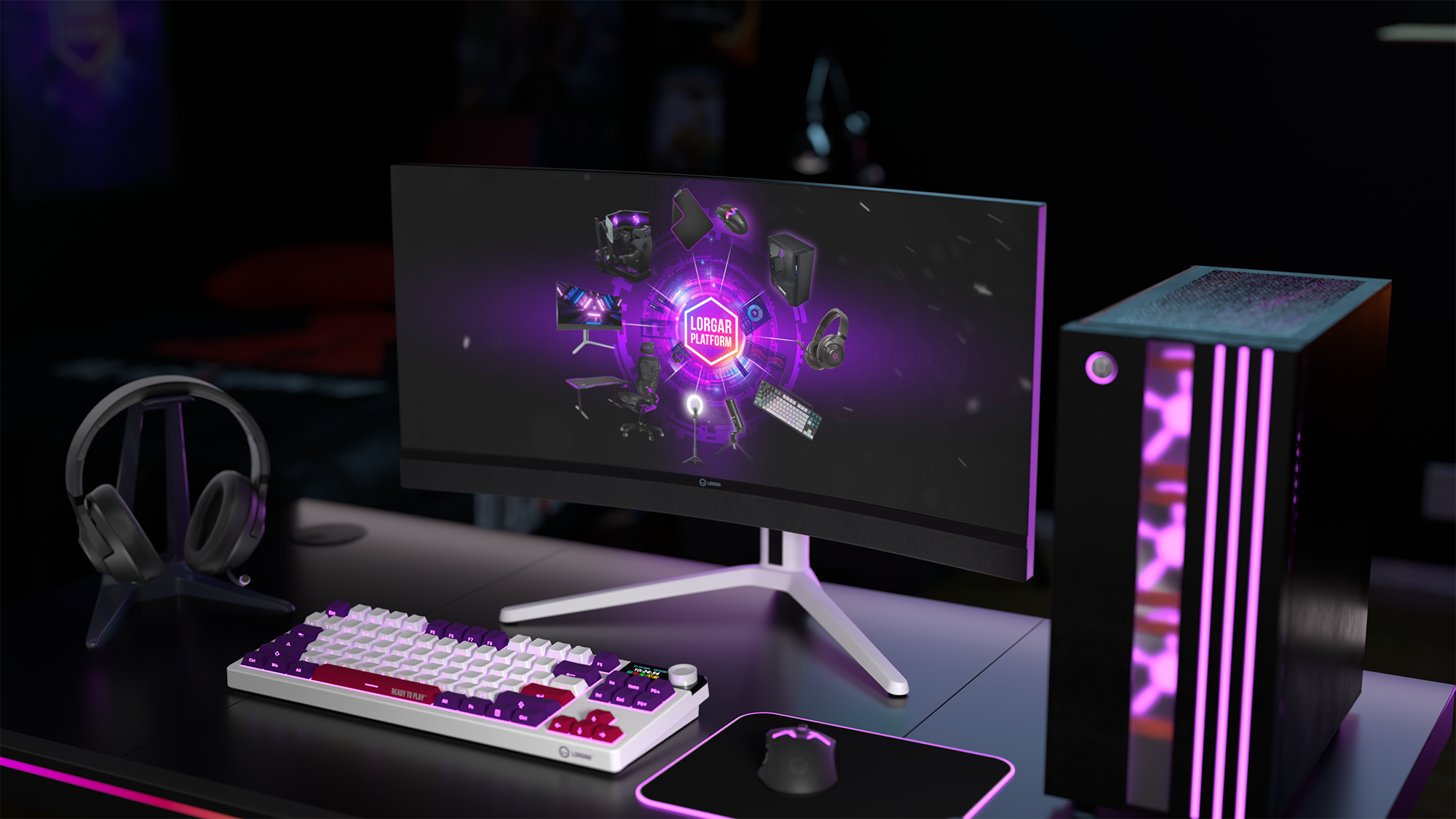




2 Responses
Hello
I have a problem with the keyboard KBP70TKLW
I can’t adjust the color of the RGB light on the side of the keyboard, it only shines red
I adjust the buttons in the software, but I can’t adjust the color on the side of the keyboard, it only shines red
Please help me
Hello!
Thank you for reaching out and for choosing Lorgar!
The side RGB lighting on your KBP70TKLW keyboard is designed to shine in red only — unfortunately, this specific part of the lighting is not customizable to other colors. We understand how important personalization can be and will share your feedback with our product team.
If you have any other questions or need further assistance, feel free to contact us — we’re here to help.
Best regards,
Team Lorgar